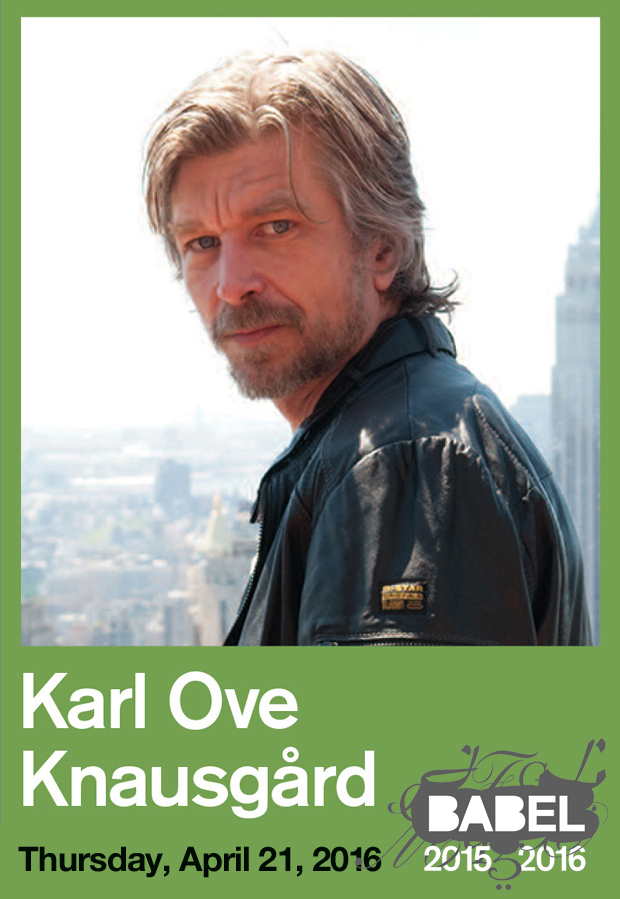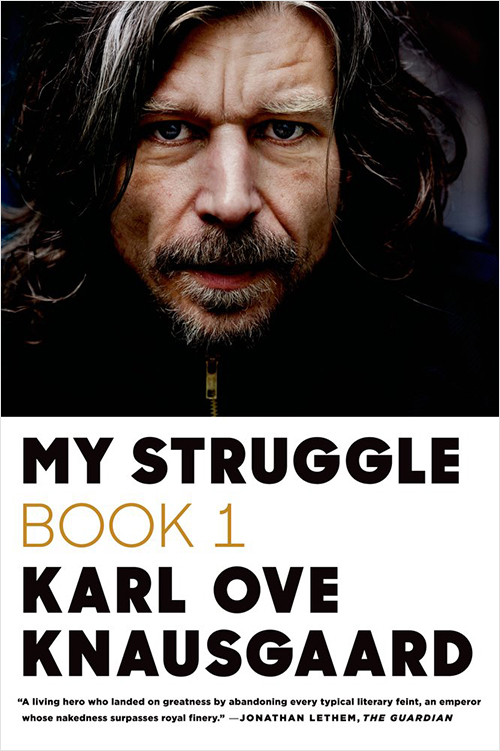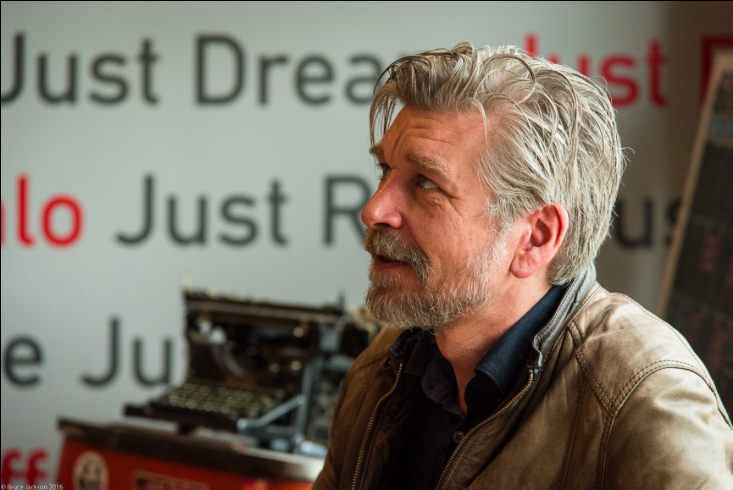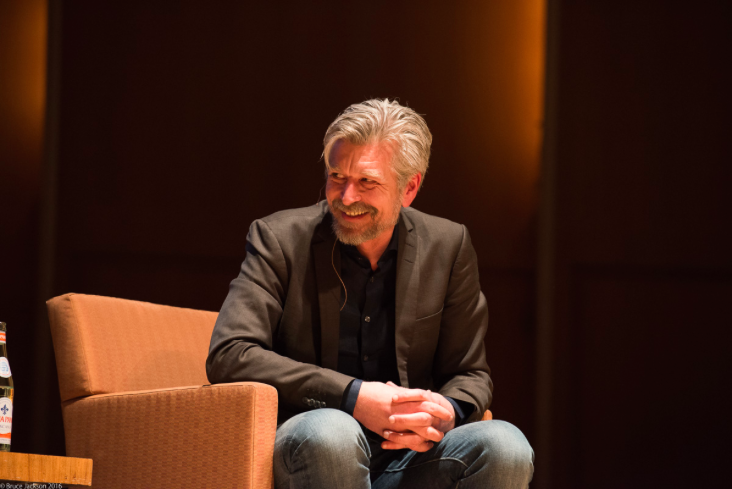Thursday, August 27, 2015 BABEL: Karl Ove Knausgård Categories: Official JB Events Timelines: 2: BABEL Archive, Just Buffalo History (2010s)

Where:
Kleinhans Music Hall
3 Symphony Circle
Buffalo, NY 14201
Date: April 21, 2016
Time: 8:00 p.m.
Patron VIP Reception: 7:00 p.m.
Photos by Bruce Jackson from the Karl Ove Knausgaard at Kleinhans Music Hall (April 21, 2016)
About the Author
KARL OVE KNAUSGÅRD has been lauded as an international literary sensation for his 6-volume epic work entitled, My Struggle. Most frequently compared to Proust, My Struggle is a memoir of hyper-realism that tackles family drama with an unflinching frankness and hypnotic attention to detail. Already translated into more than fifteen languages, the first volume translated in English was a New York Times bestseller and a New Yorker Book of the Year; Book Two was listed among the Wall Street Journal’s 2013 Books of the Year. One volume is released per year with Book Five appearing just two days before Knausgaard’s appearance here in Buffalo. BABEL readers will begin with Book One. Knausgård was born in Norway in 1968 and currently lives in Sweden with his wife and four children.
About the Book

Almost ten years have passed since Karl Ove Knausgaard’s father drank himself to death. Vulnerable and assailed by doubts, he is now embarking on a new novel. With an uncanny eye for detail, Knausgaard breaks down his own life story to its elementary particles, reliving memories, reopening wounds, and examining with candor the turbulence and the epiphanies that emerge from his own experience of fatherhood, the fallout in the wake of his father’s death, and his visceral connection to music, art, and literature. Negotiating intimacy, love, and fear lie at the heart of his movements and mind as he moves from self-deprecation to self-absorption, from craving solitude to exposing an insatiable need for love and admiration, from alienation to harmony. Karl Ove’s dilemmas strike nerves that give us raw glimpses of our particular moment in history as we witness what happens to the sensitive and churning mind of a young man trying—as if his very life depended on it—to find his place in the disjointed world around him. This Proustian masterpiece opens a window into one of the most original minds writing today.
This nerve-striking, addictive piece of hyper-realism, by the Norwegian Critics’ Prize-winning author of A Time For Everything, has created a phenomenon throughout Scandinavia.
(Read The New Republic’s profile of Knausgaard & the My Struggle series.)
Discussion Questions
- My Struggle starts with, of all things, an extended meditation on death. Knausgaard first describes what physically happens to our bodies after we die, and then he bemoans the fact that our societies are organized in such a way as to almost completely hide death from our lives. Why would someone start a book that tells the story of his life by talking about death? Do you think Knausgaard is right when he argues that we should be more aware of death in our day-to-day thoughts?
- Knausgaard writes that “as your perspective of the world increases not only is the pain it inflicts on you less but also its meaning.” Do you agree that getting a wider perspective on your life reduces its ability to cause you pain? Do you feel that Knausgaard is, in part, writing My Struggle in order to lessen the pain his own life inflicts on him? And what do you think about the trade-off he posits, that increasing our perspective lessens life’s ability to impact us?
- The first incident Knausgaard describes in My Struggle is a memory in which, as an eight-year-old boy, he thinks he sees a face in the sea on the nightly news. He explicitly links this scene to Jesus Christ and Christianity, even though organized religion is rarely mentioned in My Struggle, and Karl Ove does not seem like a very religious character. Why might Knausgaard give religion pride of place at the very beginning of the book? How might notions of spirituality be important to this project? And how do religious issues like redemption, doubt, justice, and belief in a guiding force come into play throughout Knausgaard’s story?
- The opening scenes of Karl Ove’s childhood in Book 1 are of his early adolescence; overall, the first half of Book 1 is dominated by memories from his teenage years. Why might Knausgaard want to start the tale of his life by looking at himself as a teenager? What sorts of advantages does this give him in telling the story of his relationship with his father, probably the most important relationship in My Struggle?
- Adolescence is commonly thought of as a very special part of our lives, a time when we are experimenting with freedom, and in which we are discovering emotions that we learn to control as we get older. In what ways do you find Karl Ove’s teenage years typical, and in what ways to you find them unique, and perhaps a little strange? Do you see any hints of the adult Karl Ove in the teenage Karl Ove?
- Toward the beginning of the book, Knausgaard describes the lengthy and elaborate plan required to get drunk as a teenager on New Year’s Eve. Why do you think he goes into such great detail in describing this night, and what does all this planning reveal about his character as a teen? How do you feel that this scene acts as a counterpoint to later in the novel, when Knausgaard must clean up after his father’s alcoholism? More broadly, how do alcohol and drunkenness resonate with the image Knausgaard is building of Western societies as overly sanitized?
- Regarding the rock ’n’ roll band that he played in as a teen, Knausgaard says that they were terrible but did not realize it—to the contrary, they thought they were good, and this gave their young lives meaning. How does music provide an outlet for a wilder side of Karl Ove that he is unable to express in other areas as a teenager? What does this story say about the place literature serves in his adult life? Do you think Knausgaard has doubts as to whether the literature he writes is really good or not, and whether it’s a meaningful pursuit for his life?
- Throughout My Struggle, Knausgaard frequently discusses bodily subjects that would be considered taboo by many authors; for instance, he describes how he temporarily feared as a teen that his penis was malformed, and later he describes how he was too nervous to urinate while on a date with a young woman he had a crush on. How did it make you feel to read things like this in a work of literature? And why would it be important to Knausgaard to include such details in My Struggle?
- After the divorce of Karl Ove’s parents, Knausgaard notes that his father begins to dress very differently, in a way that he characterizes as “soft” and “feminine.” It is very different from anything he has ever experienced with his father, and it distresses and confuses him. How does this contrast with the image of his father that Knausgaard builds up throughout the rest of the book? Do you feel like this offers some clues as to the roots of the divorce? And why might Knausgaard find this distressing, even though he repeatedly details how tyrannical and abusive his father could be?
- At the very end of part 1 of Book 1, Karl Ove is at a party with his now-divorced father and his father’s new friends. Karl Ove’s father is talking about a woman named Helene, whom he loved as an adolescent, and who died tragically. All this is a revelation to Karl Ove, who knew nothing about Helene growing up. During this scene, father and son are drinking together, and the teenage Karl Ove is surrounded by middle-aged people. Why do you feel that Knausgaard chose this scene to conclude part 1? And how does this scene bring together a number of the book’s important themes, like intoxication, family secrets, passionate love, and the difference between the worlds of the adult and of the adolescent?
- Part 1 of the book is all about Karl Ove’s life as a teenager, as he is getting his first tastes of adulthood while his family is disintegrating. Part 2, by contrast, is about Karl Ove leaving everything he knows in Norway to move to Stockholm, become a writer, and start a family with a new woman. Why do you think that Knausgaard chose to pair these two chunks of his life? In what ways might these two stories about profound breaks from past lives and forming new ones be similar? In what important ways are they different?
- Much of the second half of Book 1 is taken up with Karl Ove’s conflicting feelings about his father’s death: on the one hand, Karl Ove is very callous, at times even bordering on happy that his father has died; but on the other hand, he weeps without control and seems unable to believe his father is really dead. Did you feel that Knausgaard effectively captured the mixture of emotions surrounding his father’s death?
- In describing the impact of his father’s death, Knausgaard writes that he felt “as if I was entering a larger story than my own.” Yet he undercuts the epic feel of this story with very banal details, like descriptions of eating breakfast, or the CDs in his brother’s car, or even a fly buzzing around a funeral parlor. Such details drag this large story down to earth, making it feel almost dull at times. Why do you think Knausgaard does so much to give this story a feeling of conflict between great and trivial? What might this have to do with the ways in which he was processing his father’s death at the time? How does this relate to Knausgaard’s thoughts about the place of death in society, which he returns to periodically throughout the book?
- In the funeral parlor, Karl Ove notices a box of Kleenex, and it makes him think of all the other families who have been right in his exact place, grieving just as he has: “you visualized all the bereaved relatives who had come here and wept in the course of the day and you realized that your grief was not unique.” Why do you think we want to feel as though our grief is unique when we have suffered a serious loss? And how does this realization fit into Knausgaard’s larger points about the experience of reality in modern life as something false and flattened by images?
- As they’re cleaning their grandmother’s house in the aftermath of their father’s death, Karl Ove and Yngve both fall prey to the fantasy that their father is actually still alive. The idea induces a terror in Karl Ove, who imagines his father will walk through the door at any moment. How does his father’s death and the responsibilities it necessitates bring back the relationships of childhood? How does Karl Ove regress back to childhood behaviors, feelings, and memories? Do you think he manages to overcome them in the act of cleaning up after his father’s mess?
- Knausgaard spends a lot of time detailing the very difficult house cleaning involved in bringing his father’s death to a conclusion. In what ways might this work be freeing or liberating?
- Knausgaard describes a poet named Olav H. Hauge whom he interviewed as a teen: he explains Hauge’s incredible sensitivity by saying that “he was more than eighty years old, but nothing in him had died or calcified, which actually makes life far too painful to live, that’s what I think now.” Do you think having parts of you “die” or “calcify” is necessary to living without debilitating emotional pain? Is Karl Ove “calcifying” as he cleans his grandmother’s home?
- Knausgaard explains that the first time he really felt like a writer was when he wrote something about his father that made himself cry. It’s clear that his father’s approval played an important role in his decision to become a writer. What do you think Knausgaard thinks about his father deep down? Do you think his father is portrayed sympathetically in My Struggle? Fairly?
- In Book 1, Knausgaard reveals lots of very personal details, not just about himself but also about his family. The book was quite controversial when it was published in Norway, and many of Knausgaard’s family and friends were angered by what he revealed in the book. Do you think Knausgaard had a right to tell his story as he wanted to? Do we all have a right to tell our life stories, for our own sake? Should he have hidden things out of respect for those close to him?
- Officially, Knausgaard refers to My Struggle as a novel, although it obviously follows his life to the greatest extent possible. And, in fact, before writing My Struggle, Knausgaard wrote two well-received novels. In which parts of the book do you feel like Knausgaard is relying most on his talents as a novelist? How do you feel that a novelist’s storytelling ability would be useful in writing a memoir? To what extent do you think that any attempt to tell a life story is like writing a novel?
- What are your feelings about Knausgaard and this project at the end of Book 1? Do you feel like you’re willing to commit to staying with this man’s life through more volumes of My Struggle? Do you feel like this was appropriate material to cover in Book 1, and what do you expect to hear about in Book 2?





